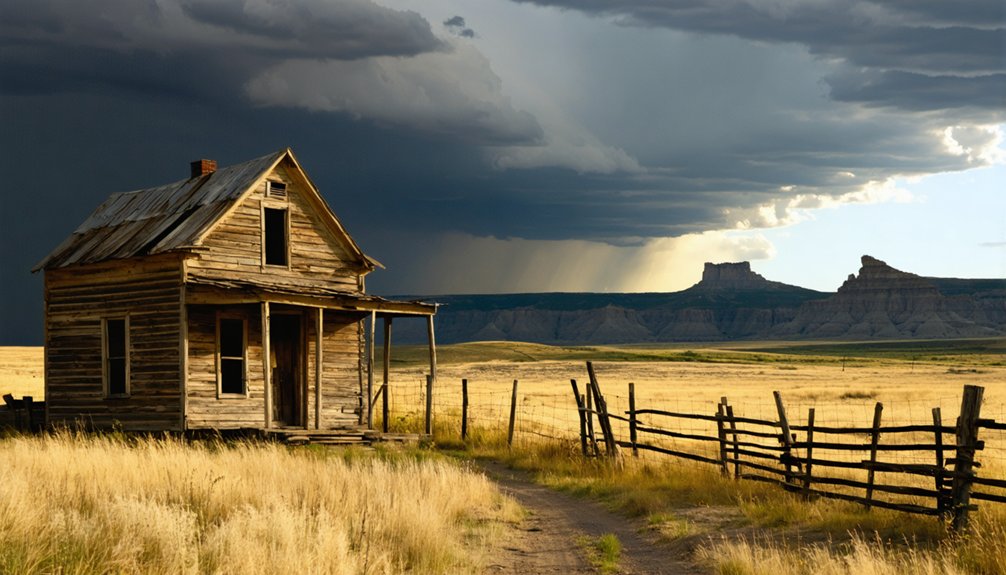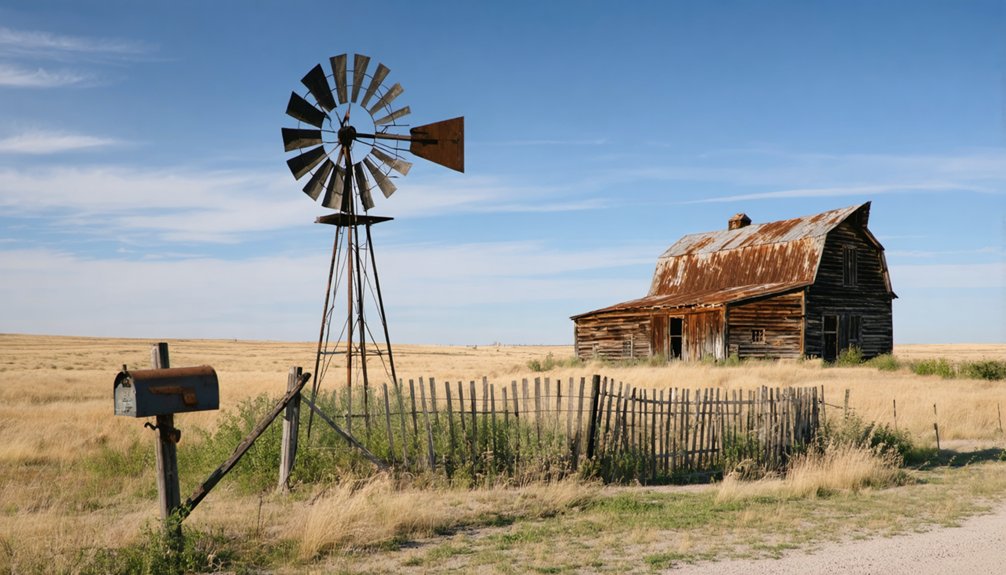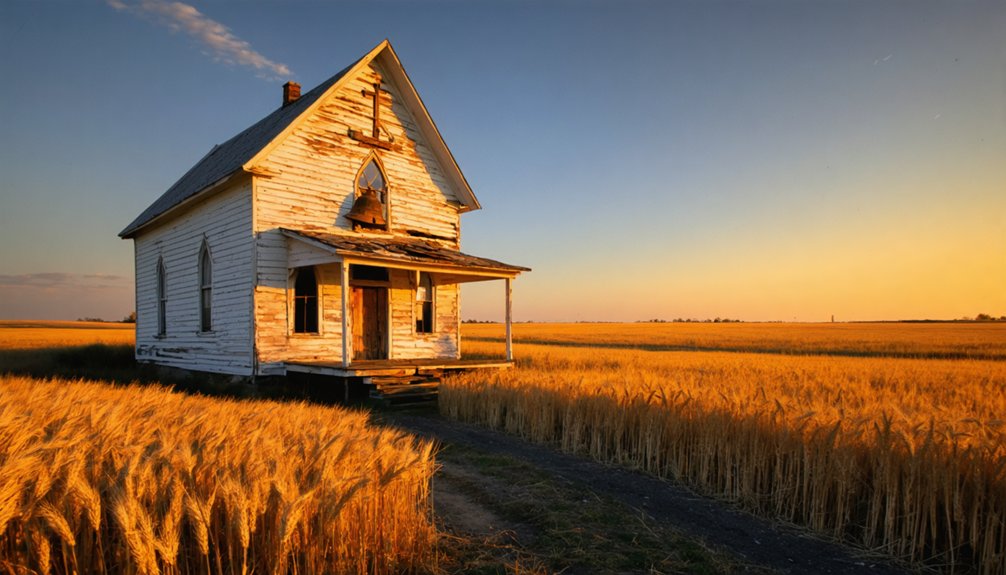You’ll find Everts, a ghost town in Walworth County, South Dakota, where cattle barons once thrived during the railroad expansion of the 1900s. The fourteen-sided barn served as a community hub while ranchers implemented innovative breeding programs and extensive grazing operations. Economic pressures, including severe drought and bypassed railroad routes, forced residents to abandon the settlement. Today, only open fields and pastures remain where this frontier town once stood, holding untold stories of pioneer life.
Key Takeaways
- Everts was established around 1900 during railroad expansion between Bowdle and Missouri River, thriving initially as a cattle ranching settlement.
- The town’s decline began when essential railroad routes bypassed it, severely limiting market access for local businesses.
- Severe drought devastated agriculture in the late 19th and early 20th centuries, forcing farmers and residents to abandon operations.
- Located in Walworth County, Everts is characterized by flat grasslands at 1,900-2,200 feet elevation with fertile prairie soil.
- Today, Everts is completely abandoned, with no standing structures remaining as nature has reclaimed the former frontier settlement.
The Rise of a Cattle Baron Settlement
As railroads expanded across the American West in the late 1800s, the cattle industry emerged as a dominant force that would shape settlements like Everts, South Dakota.
You’ll find that cattle baron practices transformed this frontier outpost, as wealthy ranchers implemented innovative breeding programs and established extensive grazing operations.
The settlement’s growth paralleled the rise of cattle barons who’d acquired vast tracts of land in the region. The Matador Land and Cattle Company was among the prominent operations that helped drive economic growth through extensive livestock operations.
As cattle barons amassed expansive territories, their growing empires fueled the transformation of frontier settlements into bustling commercial centers.
These ambitious entrepreneurs didn’t just raise cattle; they revolutionized the industry with advanced marketing strategies and efficient shipping methods.
They tackled challenges head-on, from harsh weather conditions to rustling threats, using new technologies like barbed wire to protect their investments.
Their success attracted workers, traders, and merchants, turning Everts into a hub of economic activity centered around the thriving cattle trade.
Life in 1880s Everts
In 1880s Everts, you’d find ranch hands starting their days before sunrise, tending to cattle and performing essential maintenance on wooden corrals and outbuildings.
You’d watch pioneer families struggling with the harsh realities of frontier life, from hauling water from wells to keeping warm with wood stoves during brutal Dakota winters. Sas Gilla treats and popcorn offered rare moments of enjoyment for weary residents at the local store.
Your daily survival would depend on the success of livestock operations and the careful management of limited resources, made more challenging by the town’s isolation and primitive infrastructure. Locals would gather at the fourteen-sided barn to store hay and tend to their horses, utilizing its innovative automated handling system.
Daily Ranch Operations
Three major components defined daily ranch operations in 1880s Everts: cattle management, property maintenance, and seasonal preparations.
You’d find cowboys engaged in herd management across vast stretches of unfenced prairie, where cattle grazed freely on nutritious grasses. Cattle branding and health care dominated daily tasks, while ranch hands maintained essential structures and dug wells for water access. Like Theodore Roosevelt’s ranches during the mid-1880s, operations often involved managing over 5,000 head of cattle.
- Cowboys lived in basic bunkhouses, enduring harsh Dakota winters.
- Supplies arrived by wagon or rail from Medora’s trading post.
- Ranch crews included permanent hands and seasonal workers.
- Evening hours meant gear repair and storytelling in the bunkhouse.
Working the range meant dealing with neighboring ranchers through informal grazing agreements, while keeping your herds healthy for market.
You’d spend months preparing for brutal winters by stockpiling feed and essential supplies.
Pioneer Family Challenges
Life in 1880s Everts tested pioneer families’ resilience through unrelenting environmental and social challenges.
You’d face brutal Dakota winters with minimal protection, where your wooden shelter required constant repairs against howling winds and heavy snows. Pioneer isolation meant you couldn’t count on quick help during emergencies – the nearest doctor might be days away. The remnants of these frontier dwellings still show traces of the 1930s dust storms.
Medical challenges proved especially intimidating. Without proper supplies, a simple cut could turn deadly from infection. During childbirth or disease outbreaks, you’d rely on home remedies and neighbors’ support. Similar to settlers at Round Barn Village, families had to be resourceful with limited medical options.
Your survival depended on building strong community bonds despite the miles between homesteads. You’d trade goods with other families, join forces for barn raisings, and gather at the local church – these connections were your lifeline in Everts’ harsh frontier environment.
Economic Forces Behind the Decline
Everts’ boom years came to an abrupt end when cattle barons moved their herds north due to severe drought and overgrazing in the late 1800s.
Like many towns during the 1930s hardships, residents departed for other opportunities as economic pressures and environmental challenges took their toll.
The town’s economic woes deepened as essential railroad routes bypassed the settlement, leaving local businesses cut off from wider markets and unable to ship goods efficiently.
You’d find that these transportation challenges, combined with the exodus of the cattle industry, created a devastating domino effect that crippled Everts’ remaining commercial enterprises.
The town’s situation mirrored that of nearby communities like Owanka, where the railroad water stoppage in 1935 devastated local businesses and accelerated population decline.
Cattle Industry’s Boom-Bust Cycle
Throughout the early twentieth century, South Dakota’s cattle industry experienced dramatic economic swings that profoundly shaped the fate of ranching communities.
You’ll find that cattle price fluctuations hit local operators hard, with steer prices jumping $9.60 per head between 1906 and 1907. Environmental resilience proved essential as ranchers faced devastating winters. The establishment of breed associations in later years helped stabilize the industry by enhancing confidence in registered breeding stock.
Key factors that drove the industry’s volatility:
- Harsh winters in 1881, 1887, and 1906-07 decimated herds
- Heavy dependence on Chicago and East Coast beef markets
- Dramatic shifts in national demand affecting local economies
- Forced consolidation of operations, like the Diamond A Cattle Company
The boom-bust cycle ultimately transformed South Dakota’s ranching landscape, pushing large operations to break into smaller, more manageable units. Leon E. Williams took control of several significant ranch properties after 1939, marking a major transition in local ownership patterns.
This restructuring reshaped communities like Everts, as ranchers adapted to survive.
Railroad Access Problems
As South Dakota’s transportation landscape evolved in the mid-twentieth century, Everts faced mounting challenges from declining rail access.
You’d have witnessed the town’s essential rail connections slowly disappear as government policies favored highway development over railroad preservation. The rise of trucking dealt a devastating blow to Everts’ rail service, as motor carriers offered more flexible shipping options for local farmers and ranchers.
The Minneapolis & St. Louis Railway’s extension through Everts couldn’t survive these transportation shifts.
With declining rural populations and changing agricultural needs, maintaining the rail infrastructure became too costly. By 1980, when the South Dakota Railway Authority finally stepped in, it was too late – the railroad decline had already sealed Everts’ fate.
The town’s isolation from rail networks considerably contributed to its eventual abandonment.
Drought’s Economic Impact
Severe drought conditions in the late nineteenth and early twentieth centuries devastated Everts’ agricultural foundation, triggering a catastrophic economic collapse. The town’s lack of drought resilience became evident as crop failures and livestock losses mounted, forcing many farmers and ranchers to abandon their operations.
Without economic adaptation, local businesses couldn’t survive the downward spiral.
Key impacts of the drought crisis included:
- Widespread crop failures that destroyed the farming income base
- Massive livestock selloffs due to poor grazing conditions and high feed costs
- Closure of essential services like general stores and banks
- Mass exodus of working-age residents seeking opportunities elsewhere
The economic upheaval created a vicious cycle – as people left, more businesses failed, which drove even more residents away until Everts could no longer sustain itself as a viable community.
Geographic Features and Location

The ghost town of Everts sits in Walworth County, South Dakota, where flat to rolling grasslands dominate the landscape.
You’ll find yourself at an elevation between 1,900 and 2,200 feet, surrounded by fertile prairie soil and ancient sedimentary rock formations. The geographical characteristics reflect the region’s harsh climate, with scattered trees breaking up the vast expanses of open land.
Stark prairie stretches endlessly at 2,000 feet, where lone trees dot ancient rock formations beneath harsh skies.
The terrain features tell a story of isolation, as you’re about 30 miles southeast of Mobridge, with no major highways nearby.
You’ll need to navigate dirt roads to reach this remote location. While there aren’t any significant water bodies directly adjacent to Everts, you can reach Lake Sharpe, part of the Missouri River system, by heading south.
The area’s low water table reflects the region’s typically dry conditions.
Historical Legacy and Cultural Impact
Beyond the rolling prairies and dirt roads, Everts emerged around 1900 as a vibrant frontier outpost during the railroad expansion between Bowdle and the Missouri River.
Through historical memory and cultural preservation, you’ll find a legacy that captures the spirit of frontier South Dakota, where cattle barons and railroad workers shaped the destiny of countless settlements.
- Saloons, hotels, and brothels created a lively social atmosphere catering to transient workers
- The town’s naming honors Mrs. Overholser, reflecting the importance of early settler hospitality
- Railroad infrastructure investments drove the town’s brief but intense period of prosperity
- Everts symbolizes the boom-and-bust cycle common to frontier settlements
Today, while physical structures no longer stand, Everts’ story exemplifies the deep connection between cattle, railroads, and the entrepreneurial spirit that defined America’s western expansion.
What Remains Today

Modern visitors to Everts will find little evidence of its frontier past, as this once-bustling railroad community has completely reverted to its natural state.
You’ll encounter a barren site where buildings once stood, with the land having transformed back into South Dakota’s characteristic open fields and pastures.
Unlike other ghost towns in the region, particularly those in the Black Hills that still showcase remnants of their mining heritage, Everts has undergone total environmental reversion.
You won’t find any standing structures or significant foundations to explore. The absence of preserved buildings means it’s rarely visited compared to more intact ghost towns nearby.
While the location offers little for tourists seeking tangible historical artifacts, it serves as a stark reminder of how quickly nature can reclaim abandoned settlements.
Frequently Asked Questions
Are There Any Known Photographs of Everts During Its Prime Years?
You won’t find any confirmed photographs of Everts during its prime, as historical ghost town photography of this location is scarce. Local archives haven’t revealed any documented images of Everts’ history.
What Happened to the Original Residents After Leaving Everts?
You’ll find the original residents scattered across diverse paths – many moved to Deadwood and Spearfish, while others ventured to distant mining camps or farming communities, following migration patterns that promised better opportunities.
Were There Any Notable Crimes or Sheriffs in Everts?
You won’t find documented notable crimes or sheriffs in Everts’ history. While the town had typical frontier establishments like saloons and gambling houses, no specific lawmen or criminal incidents stand out.
Did Any Famous Historical Figures Visit or Stay in Everts?
You won’t find records of famous visitors in this Black Hills mining town’s history – there’s no historical significance tied to any well-known figures staying or passing through the area.
What Native American Tribes Inhabited the Area Before Everts Was Established?
You’ll find that Sioux tribes, particularly the Lakota, dominated this region. Before them, Paleo-Indians hunted here 10,000 years ago, leaving behind artifacts like Clovis points and stone tools.
References
- https://www.youtube.com/watch?v=Glucs_Rq8Xs
- https://www.youtube.com/watch?v=_0WNYsFLSLA
- https://www.sdhspress.com/journal/south-dakota-history-2-2/some-black-hills-ghost-towns-and-their-origins/vol-02-no-2-some-black-hills-ghost-towns-and-their-origins.pdf
- https://www.sdpb.org/rural-life-and-history/2023-08-21/some-black-hills-ghost-towns-and-their-origins
- https://www.powderhouselodge.com/black-hills-attractions/fun-attractions/ghost-towns-of-western-south-dakota/
- https://www.youtube.com/watch?v=De3wGn9KDkg
- https://en.wikipedia.org/wiki/List_of_ghost_towns_in_South_Dakota
- https://www.ghosttowns.com/states/sd/everts.html
- https://icatchshadows.com/okaton-and-cottonwood-a-photographic-visit-to-two-south-dakota-ghost-towns/
- https://b1027.com/south-dakota-has-an-abundance-of-ghost-towns/



